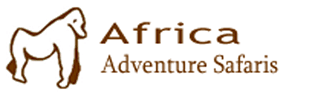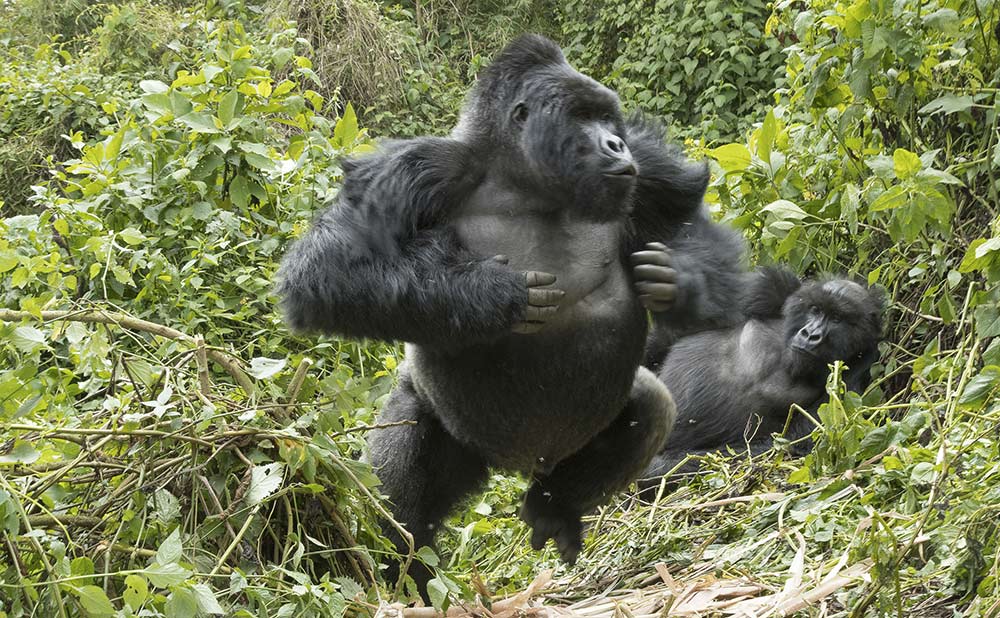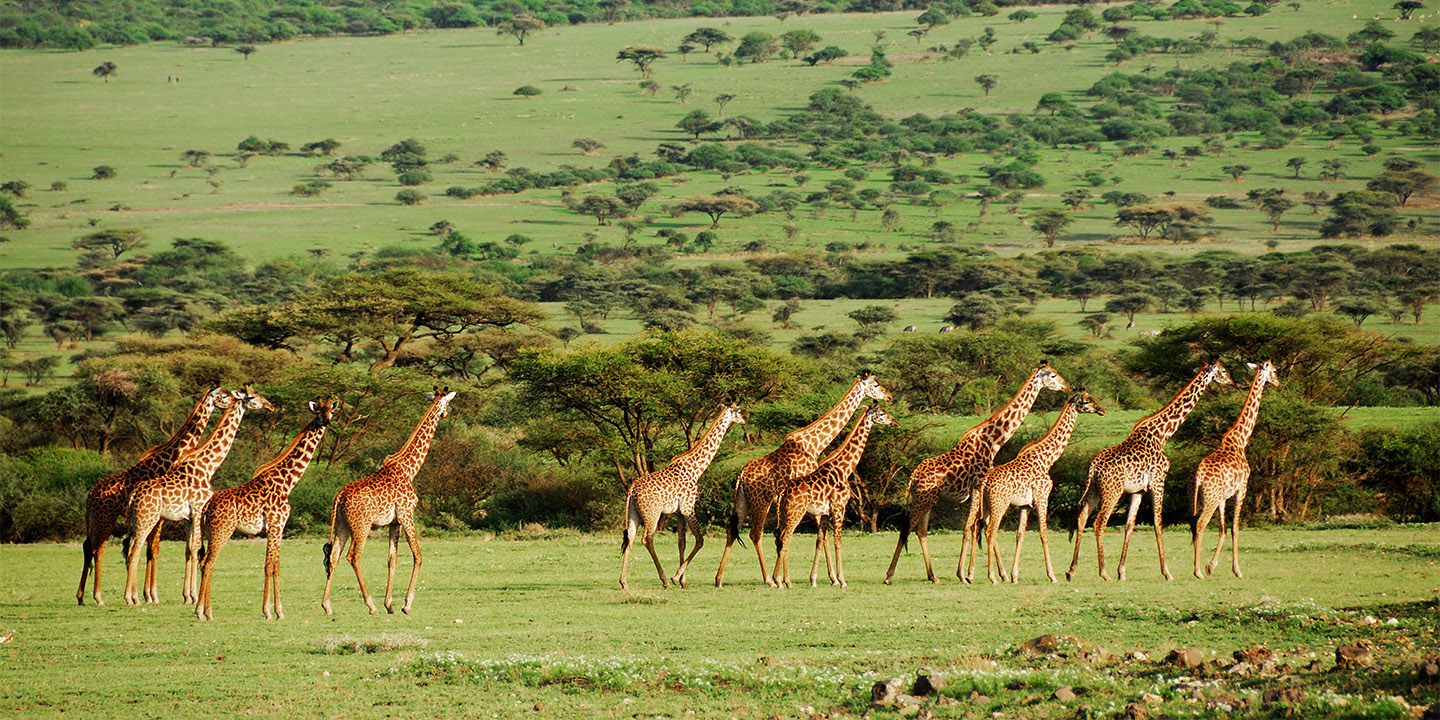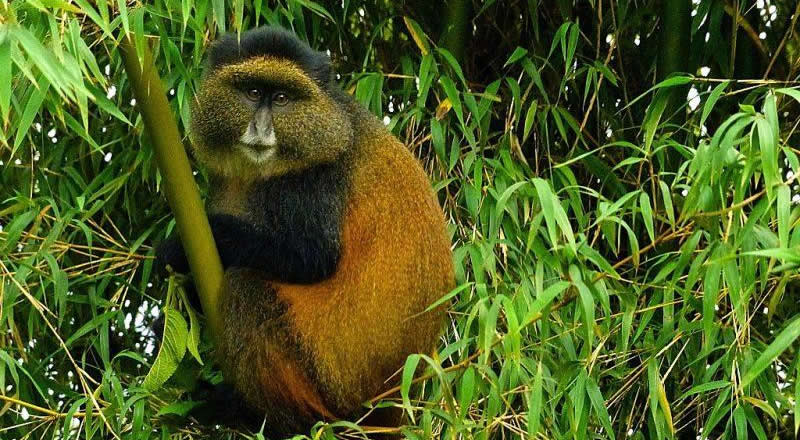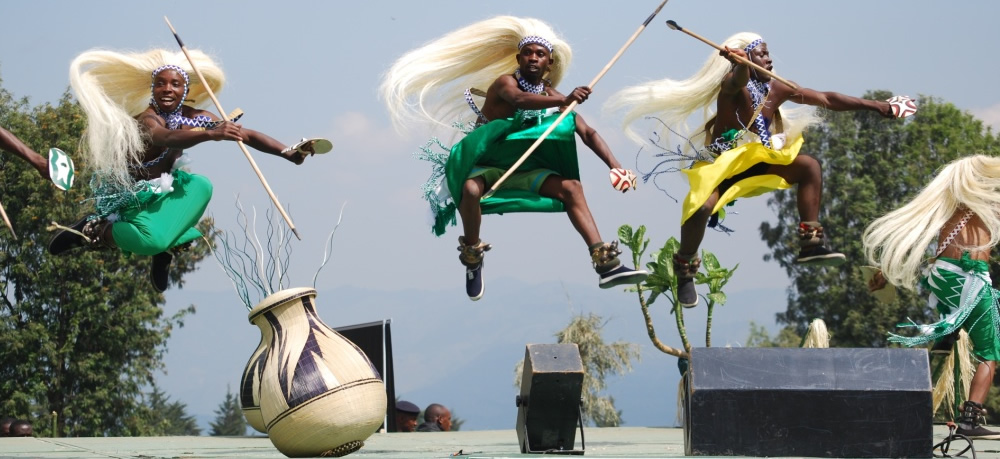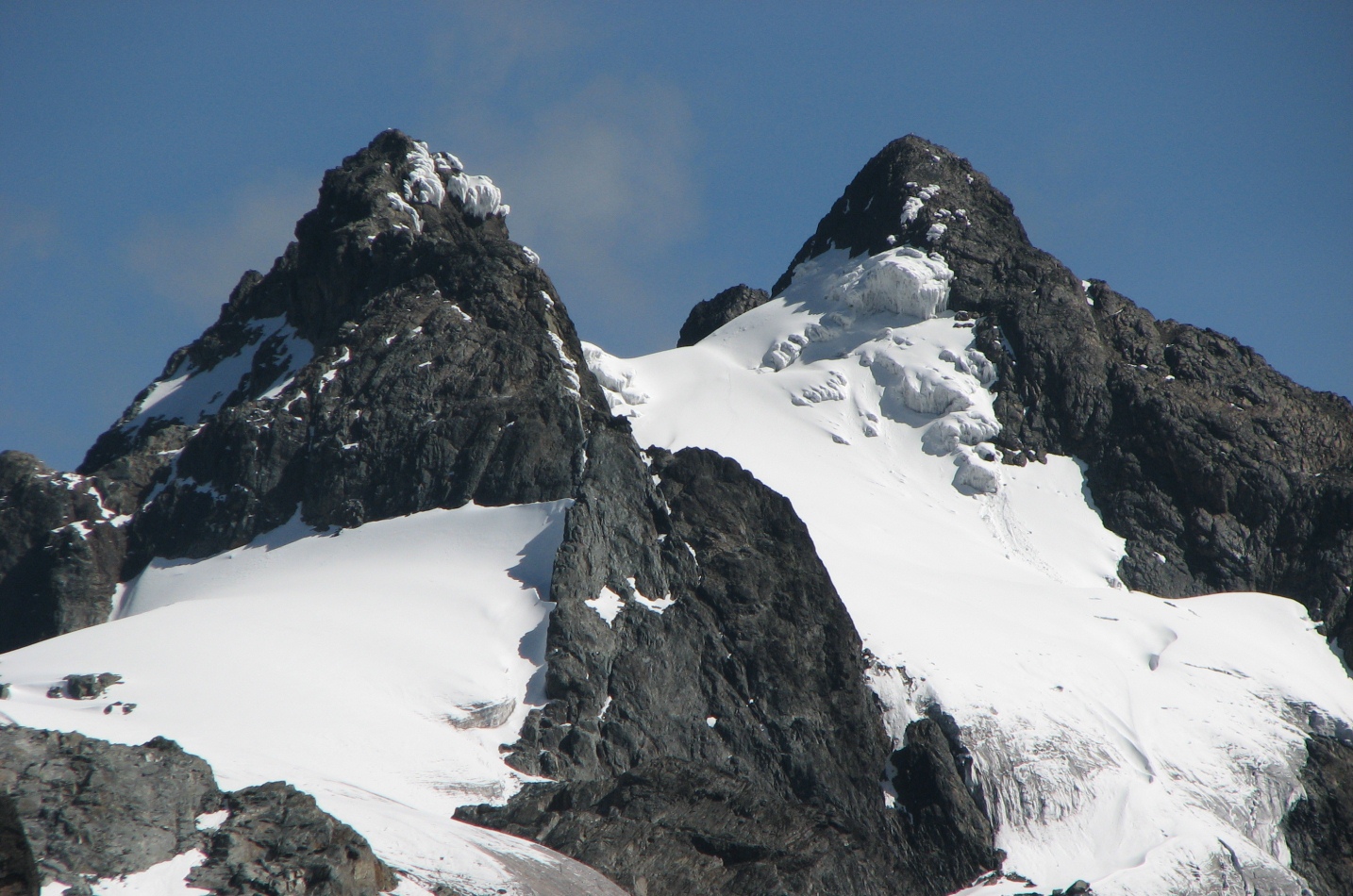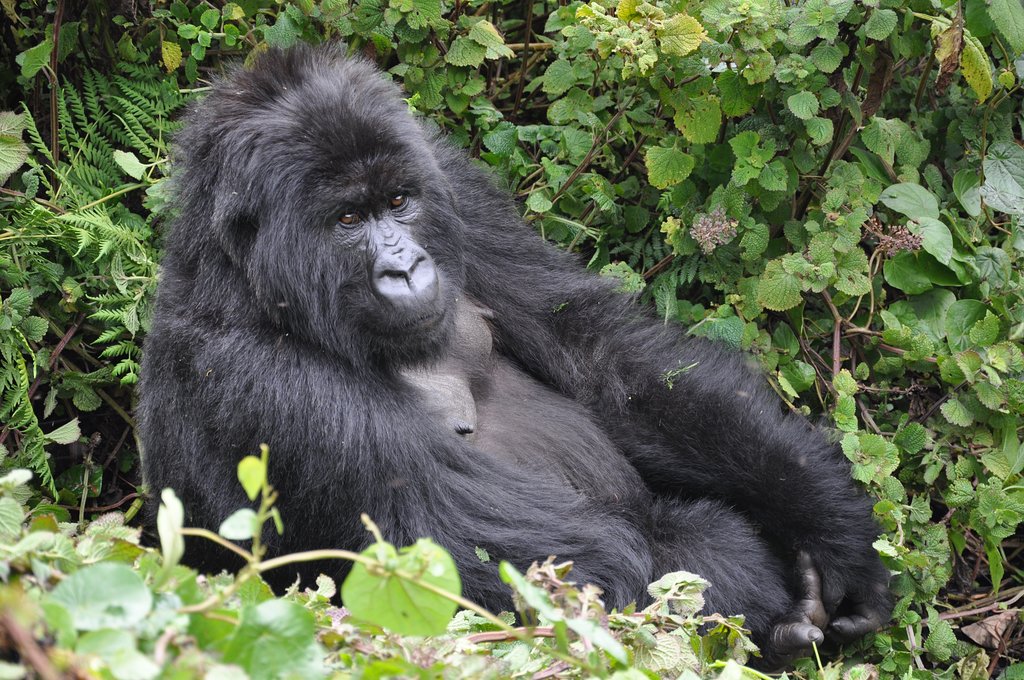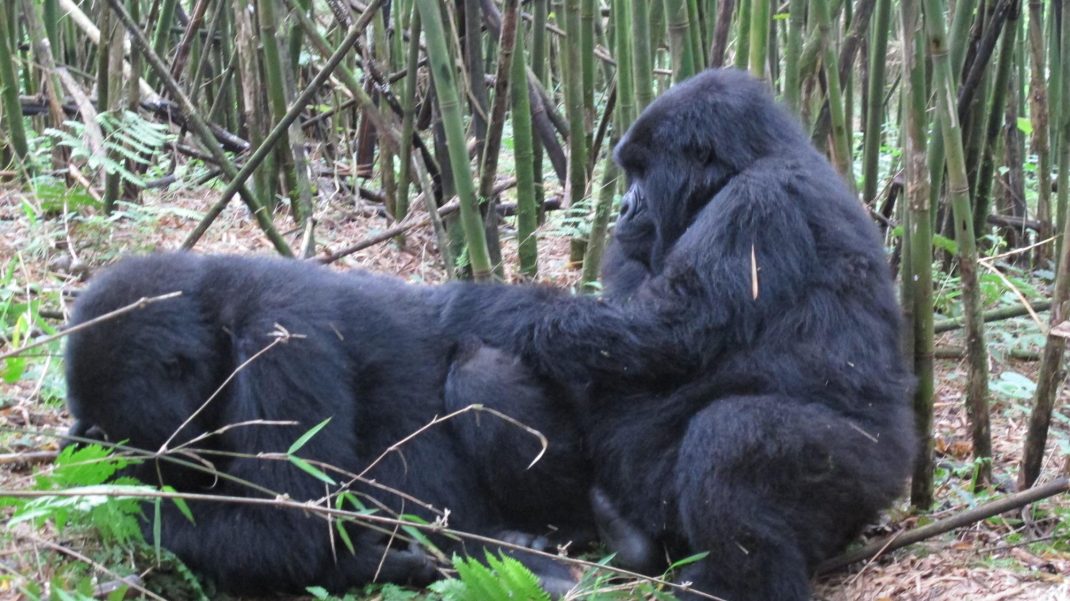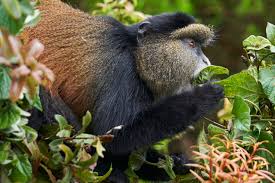Gorilla trekking is the most popular wildlife experience in Uganda, Rwanda and DR Congo. The encounter takes place in the Virunga Mountains that straddle the borders of the 3 countries and in Bwindi Impenetrable national park in southwest Uganda. Mountain gorillas are endangered species with a global population of about 1,064 animals in the wild. They were at the brink of extinction a few decades back but thanks to the intensive conservation efforts that have been undertaken that led to their recovery. In addition to Bwindi, other national parks where gorilla trekking safaris take place include Volcanoes national park in Rwanda, Mgahinga gorilla national park in Uganda, Virunga national park in Congo and Kahuzi Biega national park in Congo where lowland gorillas live.
Popular gorilla trekking safaris in Uganda and Rwanda
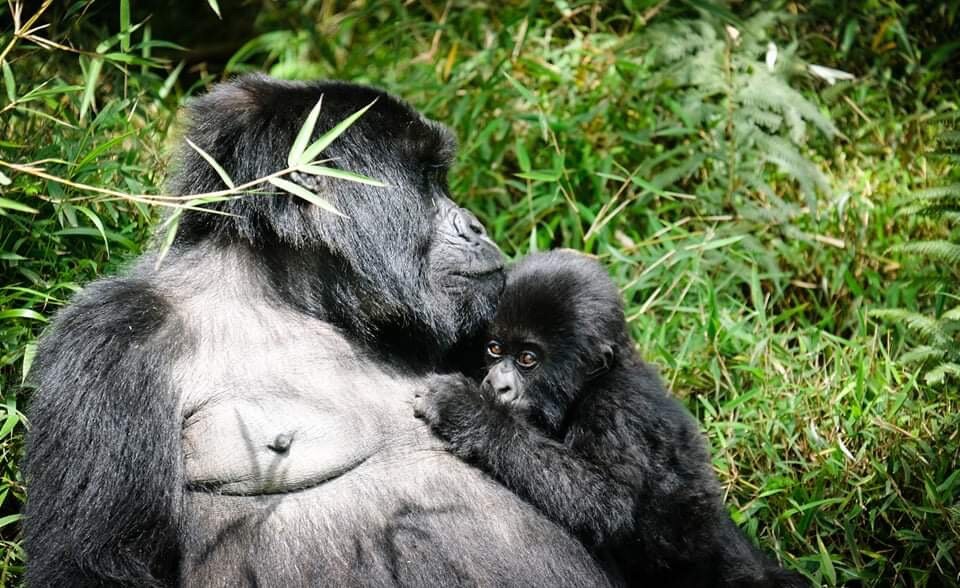
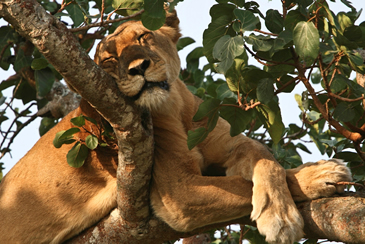
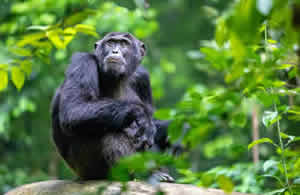
At Africa Adventure Safaris, we organize different gorilla trekking tours that take you deep into these rain forests in search of the endangered giants. These trips are available all year round and can be taken any time of the year! Gorilla treks are complemented by other activities which include game viewing in the open Savannah parks, Volcano climbing in the Virunga massif, bird watching, chimpanzee trekking, cultural tours, golden monkey trekking, bird watching and forest walks among others. A Combination of these make a complete safari package to meet, satisfy and exceed all your travel expectations.
The Gorilla Trekking Exercise
Gorilla trekking in Rwanda is a very well run conservation project. In the morning you are taken to the park headquarters where you are assigned to a gorilla group and given a briefing.
It’s possible to choose a particular gorilla group to track, but that is only possible if it was requested for early enough. If you are in a large group, it’s best if you trek the same gorilla group to easily coordinate your pickups. Also if the tour group has some unfit people, it’s best not to go for long treks. You get an hour with the gorillas once you find them. Reaching and seeing them is virtually guaranteed nowadays.
It is variable how long it takes to trek to the gorilla group because they are obviously free to roam anywhere,
The different Gorilla Groups
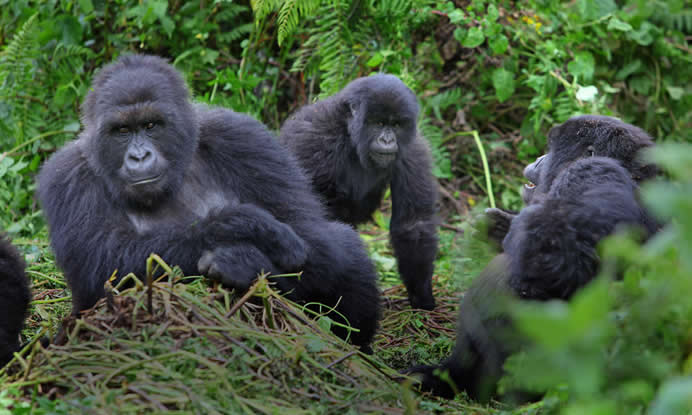
Amahoro Group (18 gorillas, ranging through all ages) 30 minute drive over extremely bumpy road to car park to start trek. Then 2 minute walk to the gorillas (loads of hurtful nettles - wear robust or waterproof-type pants because they can perforate through anything thin; if you get stung it will hurt initially but it settles within about 30 minutes or so). After nearly 10-15 minutes in the gap of the jungle (abundance of sunlight), you begin to view the gorillas move down the mountain into an area with a lot of bamboo, still reasonably open ground area but much less light. The weather is very uncertain its best to wear layers but it also gets pretty hot after walking. The whole hour with the gorillas is spent in a forested/bamboo area (low light).
Directions regarding photography
Accelerated lenses are virtually sure necessary. It is not necessary when the gorillas were in the space in unswerving sun but most of the time they aren't in such strong light.
Gorilla Trekking Packing List
Gorilla Trekking Packing List
The packing list below is just a mere guideline as you may have your own preferences:-
– 1-2 long sleeved shirts
– 3 short sleeved t-shirts
– 2 –3 pairs of light weight slacks/trousers – that can dry quickly (if wearing on treks)
– 1 pair of shorts
– 1 sweater or sweatshirt
– A waterproof and windproof jacket
– Gloves – gardening or similar (for gorilla trekking)
– Strong waterproof walking boots – pants should be tucked into socks and boots while trekking
(heavy soled rain boots also work well)
– Pair of sports sandals like Tevas
– Hat-wide brim or with a visor for sun protection
– Kleenex tissues
– Underwear
– Lightweight wool socks
-Miscellaneous
– Sunscreen
– Sunglasses with neck strap
– Insect repellent with DEET
– Small day pack
– Flashlight
– Binoculars
– Extra batteries
– Camera and extra lenses
– Film particularly fast film for the gorillas.
– Prescription medicines and possibly prescription itself
First Aid Kit including rehydration sachets, anti-diarrhea medicine, aspirin, cold medication, antiseptic cream, band-aids, motion sickness pills, lip balm, eye drops and personal medication.
Inquire
Detailed information about gorilla trekking
Both Rwanda and Uganda are home to the mountain gorillas with eastern lowland gorillas (Grauer's gorilla) found only in the DR Congo. Rwanda and Uganda are the safest places to see the mountain gorillas given that DR Congo’s Virunga national park is still closed due to insecurity in north Kivu province. The safest area to go gorilla trekking in DR Congo is Kahuzi Biega national park for those intending to visit the lowland gorillas.
Gorilla trekking in Uganda
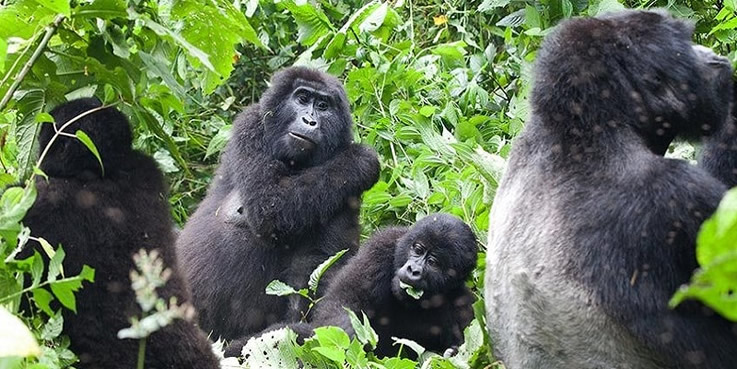
Gorilla trekking safaris in Uganda are conducted in two protected areas which include Mgahinga gorilla national park and Bwindi impenetrable national park. Both are found in southwest Uganda along the popular wildlife circuit which includes Lake Mburo, Queen Elizabeth, Kibale forest, and Murchison falls national parks.
Bwindi impenetrable national park is a UNESCO world heritage site famous for harbouring oring 459 gorillas which is almost half of the 1,063 world mountain gorilla population. At least 24 gorilla families have been habituated at the four different sectors which include Rushaga, Buhoma, Ruhija, and Nkuringo. Bwindi offers two ways to observe mountain gorillas which include gorilla trekking that allows you to spend an hour with fully habituated gorillas, and the habituation experience which allows you to spend four hours with semi-habituated gorilla groups. Uganda gorilla trekking permit cost is $800 for foreign non residents and $700 for foreign residents. The habituation permit cost is $1,500 available for booking through a tour operator or the Uganda Wildlife Authority (UWA) head offices in Kampala capital city.
The sector you choose will depend on a number of factors, including what you want to see and do in addition to gorillas. The impenetrable forest is thought to have survived the ice age. Bwindi has rich in biodiversity including 130 mammal species and 369 species of birds of which 24 are Albertine rift endemics. In addition to wildlife, there are waterfalls and cultural tours. Among other things to consider when choosing the sector include the itinerary, type of accommodation, the availability of gorilla permits in the UWA reservation systems.
Buhoma sector
The largest sector, Buhoma lies in the north at the park’s lowest altitude at 1,160 meters above sea level. The topography of Buhoma may make gorilla treks much easier. This part of the Bwindi borders the Sarambwe Nature Reserve in DR Congo accessible via Rushura trail. The sector has the park headquarters where Uganda began offering gorilla trekking safaris in 1993. There are six habituated gorilla groups of which the Mubare, Rushegura, and Habinyanja were among the first to habituated. Buhoma also has the highest number of luxury lodges including Mahogany Springs perched on the edge of the park above the Munyaga river valley. Munya river offers a self-guided nature walk. Among other activities to do in Buhoma include a village walks. This can be done to visit the Ride 4 A woman or the Batwa community outside the park. Buhoma is 129 km (3-hour drive) south of Katunguru entrance in Queen Elizabeth national park. The sector can also be reached by air through Kihihi airfield.
Ruhija sector
The Ruhija sector encompasses the northeastern portion of Bwindi and is the highest point at 2,607 meters above sea level. The Ruhija gorilla center is 44 km (1-hour drive) south east of Buhoma. Those intending to stay in a luxury lodge may still stay in Buhoma and trek gorillas in Ruhija. However, this will require one to wake up early in the morning at 5:30am for the drive. There are four gorilla groups in this area which include Oruzogo, Bitukura, and Kyaguriro, which are fully habituated. One is currently being studied.
Gorilla trekking in Ruhija can be challenging due to the nature of terrain. Especially if you’re allocated to the gorilla family with the home range on the highest peak of Rwamunyonyi (the hill of many birds). Beneath the hill, there’s the Mubwindi swamp, a high altitude marsh frequented by forest elephants. In addition to gorillas, Ruhija offers excellent bird watching with opportunity to spot Albertine rift endemics such as strange weaver and African green broadbill as well as the rare forest elephants. Ruhija offers fewer midrange lodges including Agandi Uganda Ecolodge and Bakiga Lodge, which supports water development in the community. Other things to do in Ruhija after gorilla trekking include canoeing and boat ride on Lake Bunyonyi situated 64 km (2-hour drive) from Ruhija.
Nkuringo sector
The Nkuringo lies in the southern part of Bwindi on the Nteko ridge at the edge of the Albertine rift valley. The sector offers captivating views of the forest and Virunga mountains for those who will undertake the village walk starting at Nkuringo Bwindi Gorilla Lodge. The lodge offers luxury accommodation and is located near the gorilla center. There are four gorilla groups of which one Posho is for habituation experience, and three are for gorilla trekking. Among other activities to do in Nkuringo include Buniga community forest trail to visit Batwa pygmies, nature walk to Suma waterfalls. Sundowner experience at the top of the world point with 360 ° views of the forest. Nkuringo is more easily accessible through the towns of Kabale (90km) and Kisoro (34 km). Those traveling from Kigali Rwanda via the Cyanika border town of Rwanda.
Rushaga sector
With 11 habituated gorilla families, Rushaga provides an opportunity for both gorilla trekking and gorilla habituation. The area is the most popular Bwindi gorilla sector due to a wide range of lodging options available, ranging from affordable to luxury lodges. One of our favorites, Lake Mulehe Gorilla Safari Lodge is located on the shores of a lava dammed lake providing a perfect setting for relaxation. The lodge is situated in a central location between Bwindi and Mgahinga, making it easier to visit both parks.
Mgahinga gorilla national park
The protected area is part of the Virunga mountains and the gorillas that live there are called the Virunga gorillas. They’re unique from those in Bwindi due to morphological and ecological reasons. One being that of the high elevation with the primates having a thicker coat. Mgahinga encampasses 3 of the 8 Virunga summits including Gahinga (3,474m) volcanoes, Sabinyo (3,645m), and Muhabura (4,127m). Uganda meets Rwanda and the DR Congo at the summit of Sabinyo volcano. Mgahinga is relatively smaller covering 33.7 sq.km and UWA has habituated only one gorilla group called Nyakagezi. The family has 9 members including two silverbacks with their home range on the slopes of Gahinga and Sabinyo volcanoes.
The gorillas used to be migratory, heading to Rwanda and DR Congo however. It has settled within Uganda’s borders based on the ground UWA rangers. Visitors are assured of a great gorilla trekking experience with the advantage of easy to moderate treks due to the nature of terrain. The vegetation cover in Mgahinga includes montane woodland, montane forests, bamboo, hagenia-hypericum, tree heathers, and Afromontane zone. The bamboo and ericaceous zones are characterized by little undergrowth when compared to the dense and thick vegetation of Bwindi. Trekking begins at Ntebeko park visitor center at 2,364 meters above sea level where briefing is conducted at 7:30am. The walk from there to the trailheads may take 1 hour and winds through former farmland with a mixture of vegetation. The bamboo zone is home to golden monkeys and Mgahinga is a place where gold meets silver. The endangered primates are endemic to Virunga area and their body is marked with golden patches
Gorilla trekking in Rwanda
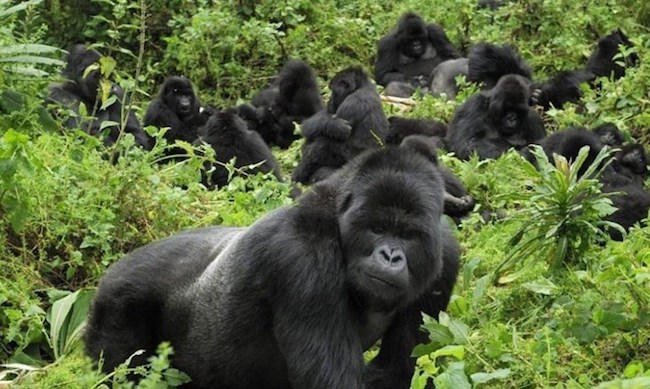
Gorilla trekking in Rwanda is done in Volcanoes national park, where the legendary primatologist Dian Fossey lived among the mountain gorillas for almost 20 years. She established the Karisoke research center in 1967. At the time of her murder in 1985, the Virunga gorilla population was estimated to be less than 200 individuals. Fossey is remembered for pioneering active conservation which Rwanda took advantage of to create a world class primate scientific research hub at the new Ellen DeGeneres Campus of the Dian Fossey Gorilla Fund.
Gorilla trekking in Rwanda focuses on a low impact-high end tourism strategy which keeps visitor numbers low to conserve gorillas. Rwanda gorilla permit cost is $1,500 per person available for booking through the Rwanda Development Board or a tour operator. Trekking begins at Kinigi park headquarters at 2,200 meters above sea level. Some of the gorilla families including Sabinyo are known to live closer to the briefing center, making for an easier gorilla trek. Other gorilla groups such as Susa-B stay on the slopes of Mount Karisimbi 4,507 meters (14,787 feet), Rwanda’s highest point. If you’re allocated to such groups, the trek to reach them can be challenging due to the nature of terrain.
The difficulty of a gorilla trek depends on several factors including seasons. June to September and December to February are the best months for gorilla trekking in Rwanda. Paths in the forest are relatively drier which is ideal for hiking, however. During the dry season, the foraging patterns of gorillas make them move deeper into the valleys where there are fresh plants. Treks might be longer, taking 5 to 8 hours. During the rainy season, the foraging patterns are different. The primates tend to feed near the park boundary or spend much time in the same area. Treks may be shorter but the trails are muddy and slippery so you should pack guitars for extra leg protection.
Getting there
Volcanoes national park is 104 km (2-hour drive) north of Kigali capital city. Ruhengeri town also known as Musanze is 10 km away from the briefing center at Kinigi. The town offers a wide range of accommodations as well as banking facilities, restaurants, and Rwanda Rwanda Development Board offices. Some of the best midrange and luxury lodges near the park include Sabyinyo Silverback Gorilla Lodge, Tiroleza Volcanoes Ecolodge, Mountain Gorilla View Lodge, Gorilla Solutions Lodge, Da Vinci Gorilla Lodge, Le Bambou lodge, and Five Volcanoes Boutique hotel.
Lowland Gorilla Trekking In Kahuzi Biega National Park
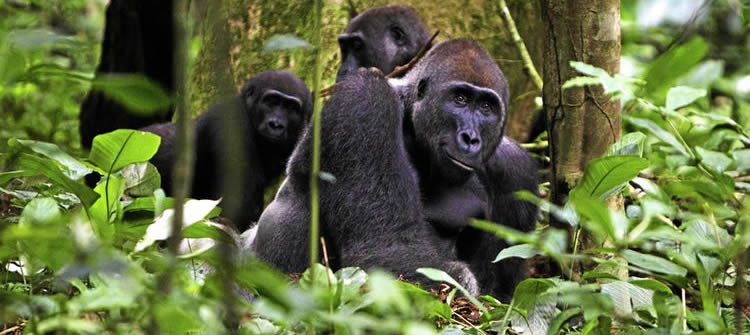
Kahuzi Biega national park visitor center at Tshivanga is 34 km (1-hour drive) north of Bukavu capital city of South Kivu province, eastern DR Congo. Bukavu is 16 km across the border from Cyangugu town in south west Rwanda. Cyangugu is 25 km west of Gisakura the eastern entrance of Nyungwe national park. From Kigali capital city via Butare to Cyangugu is 125 km (3-hour drive). Bukavu is 200 km (6-hour drive) south of Goma city via the road along the shores of Lake Kivu. Alternatively, the park can be reached by air from Kigali or Bujumbura through Kamembe airport.
Kahuzi Biega is safe to visit to see the lowland gorillas and those intending to go there need to fly to Rwanda or Burundi. You would be undertaking an adventure trip to one of central Africa’s remote destinations. Kahuzi Biega spans for 6,000 sq.km in the area where the Albertine rift valley meets the Congo rainforest. The park’s major physical features are Mount Kahuzi (3,308 m) and Mt. Biega (2,790 m) which are extinct volcanoes. From high to low elevation, the vegetation includes sub-alpine prairies and heather, dense Afro-montane and lowland forests, bamboo, and swamps.
The protected area was designated as a Center Of Plant Diversity with over 1,178 plant species including the senecio kahuzicus and dendrosenecio erici-rosenii. Due to a variety of habitats, the protected area is rich in biodiversity including over 250 lowland gorillas. Among other 13 primate species include chimpanzees, owl-faced monkeys, blue monkeys, black and white colobus monkeys and yellow baboons. There are 136 mammal species, which is higher than that of Bwindi impenetrable forest which include the bongo, forest elephants and buffaloes, giant forest genets, aquatic genets, and giant forest hogs. Over 349 species of birds are recorded of which 42 are Albertine rift endemics including the white-naped pigeon (Columba albinucha) and Lagden’s bushrike (Malaconotus lagdeni).
Gorilla trekking is the number one attraction given that Grauer’s gorillas are endemic to eastern DR Congo. They’re the largest of the four gorilla subspecies and are critically endangered on the IUCN RedList of endangered species. According to the Dian Fossey Gorilla Fund, their population might have declined by 50% since the 1990s. An estimated 35,000 individuals left in the wild with their habitat range extending to Maiko National Park and Itombe forests. Kahuzi Biega national park alone is famous for harboring 250 individuals of which four groups have been habituated for trekking since 1972 which include Mubalala with 10 members, Maheshe (16), Nindja 20, and Mushamuka 19. This means that they’re well accustomed to human presence.
Gorilla trekking procedure in Kahuzi Biega national park
Those intending to visit the park are recommended to book their gorilla permits in advance. Kahuzi Biega gorilla permit cost is $400 for regular trekking and $600 for the habituation experience available for booking through the Tshivanga visitor center, the Zaire Institute for the Conservation of Nature (IZCN) regional offices in Bukavu city or a tour operator. Gorilla treks begin at the center with briefing at 7 am local time in the morning. Visits are limited to 1 hour for a maximum of 8 people per gorilla family. The age limit for children is 15 years old.
Other activities to do In Kahuzi Biega national park
Among other activities to do include hiking the volcanoes which include Mt. Kahuzi, Mt. Biega, and Mt. Bugulumiza. Hiking permit cost is $100 for adults and $70 for international students. Climbing Mount Kahuzi, the highest volcano peak in the park at 3,308 meters, takes 4 hours. This hike immerses you into nature as you walk through gardens of rare plant species of senecios and lobelias. Hiking Mount Biega at 2,790 meters and lasts 2 hours and the trail winds through unique vegetation of giant heathers. The trail to Mt. Bugulumiza is 6 km long and can be reached by foot or vehicle. Besides hiking, there are several nature trails that begin at Tshivanga visitor center which include the Mbayo trail which provide opportunities for spotting birds, primates and mammal species.
Where to stay
Kahuzi Biega national park has fewer accommodation options which include tents and cottages inside the park next to the visitor center. Other places of stay are found in Bukavu city and include Orchid safari club hotel, Riviera hotel and Residence hotel.
